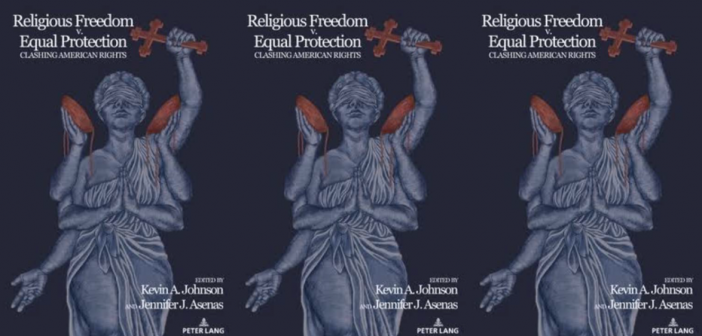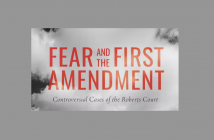Researchers from the Center for First Amendment Studies recently published an edited volume on the subject of recent clashes between “religious freedom” and “equal protection.” The book introduces the terms as rhetorically contested and defined by cases that have clashed in legal and public debates. The book introduces a range of important subjects, including child torture and access to mandatory reporters, placing children into adoptive homes, prayer in public schools, religious tax exemptions, roadside memorials, military draft exemptions, access to contraceptive and family planning services, regulation of broadcast media, business exercises of religious freedom, issues of immigration detention, tribal sovereignty, and issues of political correctness and conspiracy theories. The book is a collaborative project with researchers from across the country.
The first four essays pertain to the role of religious freedom and equality when it comes to the nation’s youth. The first two of these focus on the relationships between parents and children. Lindsey A. Sherill examines the conflict between the religious freedom of parents and the equal protection of children to access mandated reporters. Sherill specifically examines the way religious freedom shields cases of child torture, abuse, and neglect when children are denied equal access to the mandated reporters of those crimes. Pamela Morris and Susan Sarapin work through the conflict between equal protection of children and adoption agencies, the religious freedom of adoption agencies, and the issues surrounding government endorsement of religion in supporting religious adoption agencies. They specifically work through the problem whereby 437,000 children are living in foster homes and 125,000 are waiting to be adopted, while at the same time the murky legal situations of sectarian adoption agencies and their religious freedom inhibits their ability to assist an overtaxed child welfare system. One of their fundamental claims is that the lack of legal clarity contributes to the government’s failure to meet the needs of children.
The next two essays examine the clash between religious freedom and equality when it comes to educating the nation’s youth. Adrienne Hacker-Daniels provides an in-depth analysis of the Board of Education of Kiryas Joel Village School District v. Grumet case, involving religious freedom, equal protection for special education, and questions that are homologous to the landmark Brown v. Board of Education case. In doing so, she advances the idea that equal protection and religious freedom clashes might be better understand not as a matter of stasis (i.e., the kind of arguments traditionally found in forensic courtroom kinds of rhetoric), but rather as a form of aystatic theory that draws on questions of balance and inconclusiveness. Elizabeth Thorpe examines recent developments in cases that involve the religious rights of prayer in public schools. She suggests that many of the Establishment Clause cases about government endorsement of religion may be less problematic if treated more in terms of Equal Protection Clause jurisprudence. Namely, that the conflict over religious freedom and equal protection appears to be, perhaps ironically, an equal unprotection—people expressing secular viewpoints are more protected than those who express religious viewpoints. These tensions are, of course, more complicated than even what they appear to be at first glance.
The next set of essays are comprised of three areas of study concerning questions about government endorsements and accommodations of religion. Juliet Dee studies the nature and scope of the Johnson Amendment and its relationship to and with tax codes pertaining to exemptions for religious organizations. Dee highlights the tension between religious leaders who seek to exercise a First Amendment right of electioneering communication for candidates that may be in favor of their interests (i.e., advocating for candidates in favor of upholding religious freedom), and the equal protection of the general public who may in effect be required to subsidize the religious leaders’ speech through the tax exemption. Amanda Reid takes up issues pertaining to roadside religious memorials. There are many government regulations pertaining to roadside memorials in terms of religious symbols (i.e., the time, distance between and away from roads, upkeep, and more). Reid suggests that there is a tension in terms of equal protection of the public land use, and the potential for selective nonenforcement of laws that may result in government endorsement of religion concerns. David Dewberry and Pat Arneson review the issue of draft exemption for conscientious objectors. In analyzing the case of Gibson v. United States, they argue the difference between equal protection and religious freedom lies in the stark contrast of legal and communication paradigms—potentially irreconcilable differences in the practices of the selective service.
The next set of essays work through equal protection and religious freedom conflicts that have arisen out of the implementation of the Religious Freedom Restoration Act (RFRA). The first two of these essays are on the case of Burwell v. Hobby Lobby. Skye de Saint Felix examines the implications of the Court’s decision to define corporations’ religious freedom based on part of a corporation (i.e., the owners and shareholders, and not the employees), and also the impacts that the decision has had for women’s equality. Saint Felix also examines the implications of RFRA and other cases like Masterpiece Cakeshop v. Colorado that privilege the freedom of religion over the recognition of gender equality. Joseph Sery examines the rhetorical choices of Justice Alito’s majority opinion in Hobby Lobby. Drawing on Thomas Goodnight’s idea of the “three spheres of argumentation,” Sery argues that the primary rhetorical appeal of the personal sphere of argumentation that exists in religious freedom arguments functions to undermine the technical sphere of medical consensus, and in doing so further marginalizes concerns about equal protection in the public sphere of argumentation. Jason Zenor examines the impact of RFRA on Native American sovereignty and religion. Zenor examines the Sioux tribes’ loss in their RFRA claim against the Dakota Access Pipeline, specifically to the way Native American rights are rhetorically questioned in terms of their “sincerity” and whether the tests for Native American sincerely held religious beliefs are equally applied to other similar religious freedom claims.
The last set of essays cover a few of the culture clashes that have played out in American life. These essays are less concerned with the way equality and religious freedom have played out in legal conflicts, and more concerned with the implications and lessons to learn from the cultural politics of equal protection and religious freedom. Diana Martίnez, Jamila Cupid, and Robert Mejia examine the conflicts between Christian nationalism and the equal protection of migrant people who suffer separation from family members, the enduring of abuse, neglect, assault, and other atrocities. Specifically, they examine elements of visual rhetoric that, from a Christian nationalist framing comes to view immigrants as deficient rather than as human rights abuses, and how that framing impacts the unequal protection of human rights and the perpetuation of citizenship excess. Ann Burnette and Rebekah Fox examine the case of Masterpiece Cakeshop v. Colorado Civil Rights Commission in order to account for the complex cultural values that clashed in the case, arguing that the case was never about just a cake but about a fundamental clash between equal protection and religious freedom that permeates American cultural politics and the right to claim discrimination on the basis of a person’s identity and a person’s beliefs. Mark Ward, Sr. examines the implications of media deregulation and the “equal protection” of proliferating private media spaces. Ward examines the religious freedom claims of Bob Shuler and other televangelists as congruent with privatized equal protection and conflicting with public equal protection. He argues that the rise of the deregulation form of equal protection mirrors the decline of public deliberation and increase in sectarianism. Logan Spence studies the conflict between religious freedom and equal protection in the “war on Christmas.” Spence examines the way that the rhetoric of political correctness grew out of a version of equal protection that gave rise to conspiracy theories within American Christian groups who performed a paranoid style by constructing a story about a “war on Christmas.”
The book is available for purchase at https://www.peterlang.com/document/1190579




